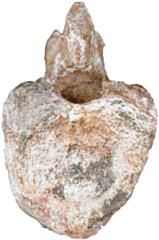Project 3333: E. Gorscak, U. Joger, P. M. O’Connor. 2019. A new African Titanosaurian Sauropod Dinosaur from the middle Cretaceous Galula Formation (Mtuka Member), Rukwa Rift Basin, Southwestern Tanzania. PLOS ONE. 14 (2):e0211412.
Abstract
The African terrestrial fossil record has been limited in its contribution to our understanding of both regional and global Cretaceous paleobiogeography, an interval of significant geologic and macroevolutionary change. A common component in Cretaceous African faunas, titanosaurian sauropods diversified into one of the most specious groups of dinosaurs worldwide. Here we describe the new titanosaurian Mnyamawamtuka moyowamkia gen. et sp. nov. from the Mtuka Member of the Galula Formation in southwest Tanzania. The new specimen preserves teeth, elements from all regions of the postcranial axial skeleton, parts of both appendicular girdles, and portions of both limbs including a complete metatarsus. Unique traits of M. moyowamkia include the lack of an interpostzygapophyseal lamina in posterior dorsal vertebrae, pronounced posterolateral expansion of middle caudal centra, and an unusually small sternal plate. Phylogenetic analyses consistently place M. moyowamkia as either a close relative to lithostrotian titanosaurians (e.g., parsimony, uncalibrated Bayesian analyses) or as a lithostrotian and sister taxon to Malawisaurus dixeyi from the nearby Aptian? Dinosaur Beds of Malawi (e.g., tip-dating Bayesian analyses). M. moyowamkia shares a few features with M. dixeyi, including semi- spatulate teeth and a median lamina between the neural canal and interpostzygapophyseal lamina in anterior dorsal vertebrae. Both comparative morphology and phylogenetic analyses support Mnyamawamtuka as a distinct and distant relative to Rukwatitan bisepultus and Shingopana songwensis from the younger Namba Member of the Galula Formation with these results largely congruent with newly constrained ages for the Mtuka Member (Aptian–Cenomanian) and Namba Member (Campanian). Coupled with recent discoveries from the Dahkla Oasis, Egypt (e.g., Mansourasaurus shahinae) and other parts of continental Afro-Arabia, the Tanzania titanosaurians refine perspectives on the development of African terrestrial faunas throughout the Cretaceous—a critical step in understanding non-marine paleobiogeographic patterns of Africa that have remained elusive until the past few years.Read the article »
Article DOI: 10.1371/journal.pone.0211412
Project DOI: 10.7934/P3333, http://dx.doi.org/10.7934/P3333
| This project contains |
|---|
Download Project SDD File |
Currently Viewing:
MorphoBank Project 3333
MorphoBank Project 3333
- Creation Date:
16 November 2018 - Publication Date:
22 February 2019
This research
supported by
Authors' Institutions ![]()
- Ohio University
- Field Museum of Natural History
- Midwestern University
Members
| member name | taxa |
specimens |
media | media notes |
| Eric Gorscak Project Administrator | 1 | 1 | 6 | 6 |
| Patrick O'Connor Full membership | 0 | 0 | 0 | 0 |
Project has no matrices defined.
Project downloads 
| type | number of downloads | Individual items downloaded (where applicable) |
| Total downloads from project | 152 | |
| Document downloads | 4 | Parsimony Nexus File (2 downloads); Excel File (1 download); SUPPLEMENTAL: Materials and Methods (1 download); |
| Project downloads | 148 |

